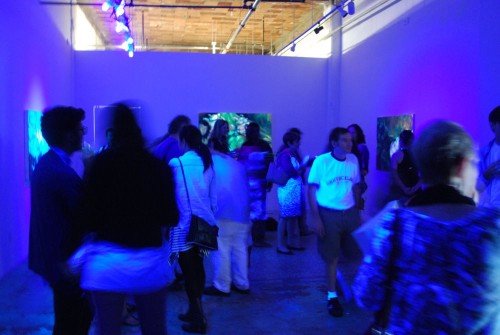
Inside the black light installation at the opening reception for "Lily Simonson: Wet and Wild" at CB1 Gallery. Courtesy Jason Chang CB1 Gallery.
Like so many celebrities, Joan Quinn’s larger-than-life presence is counterbalanced by her surprisingly diminutive stature. Though not an international household name, Quinn is known throughout the LA art world for both her continuing patronage of Southern California artists and her longtime role as West Coast Editor for Interview Magazine. Moreover she has been the subject of nearly 200 portraits over the past four decades by artists from a broad cross section of the Angelino art world—from heroes David Hockney and Ed Ruscha to emerging artists. The collection was brought into the public in the form of the exhibition and accompanying catalogue entitled Mysterious Objects.
My own exchange with Quinn has been something of a whirlwind. Within a week of completing and installing all the work for my solo show Wet and Wild at CB1 Gallery, my newly emptied studio was refilled by the dynamic energy of Quinn herself. She had invited me to join in the ongoing project of portraying her, and subsequently appear as a guest on her television program, The Joan Quinn Profiles and display the finished painting on set. Since most of my models are dead bugs and sea critters, the appearance of a human being in the studio really shook things up.
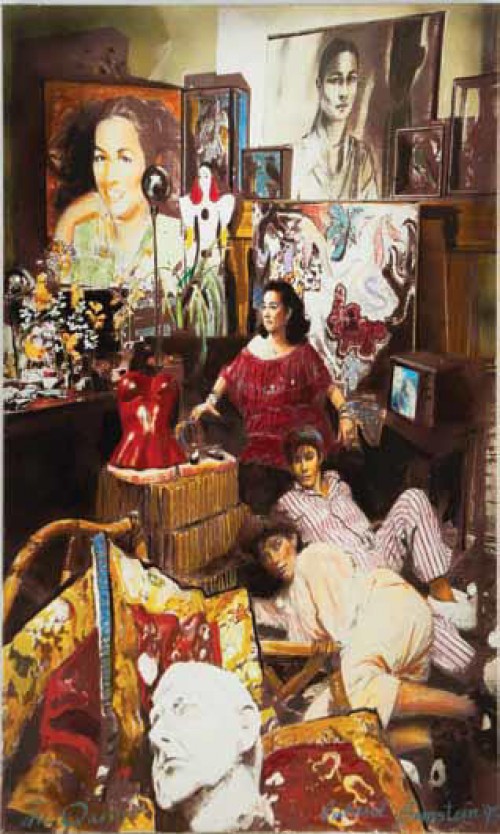
Richard Bernstein, 1995, original photograph for House and Garden magazine by Helmut Newton, reproduced on canvas with silkscreen, pencil, pastel and acrylic, 60 x 36 inches. Courtesy "Mysterious Objects: Portraits of Joan Quinn," catalogue published by the Santa Ana College Foundation.
The representations of Quinn morph tremendously throughout the collection, her figure operating as a vessel for each artist to manifest his or her perspective, just as my deep sea subjects serve as starting points for my own investigations of more anthrocentric philosophical questions. Moreover, many non-figurative artists, such as Larry Bell, have ventured into the realm of portraiture only for Quinn. So despite my typical focus on non-human subjects, I jumped at the chance to paint Quinn. Immediately probing through dozens of canvases in my studio storage, Quinn adamantly encouraged me to sustain my own voice, and paint her as I would any of my typical invertebrate subjects. While I rarely invoke the human form in my paintings, I often use “lower life forms” to imply human narratives, their exoskeletons coquettishly suggesting human flesh. In addition, I immediately felt an affinity with the obsessively thorough, serial aspect of the Quinn portraits, given that my practice focuses on painting specific species hundreds of times.
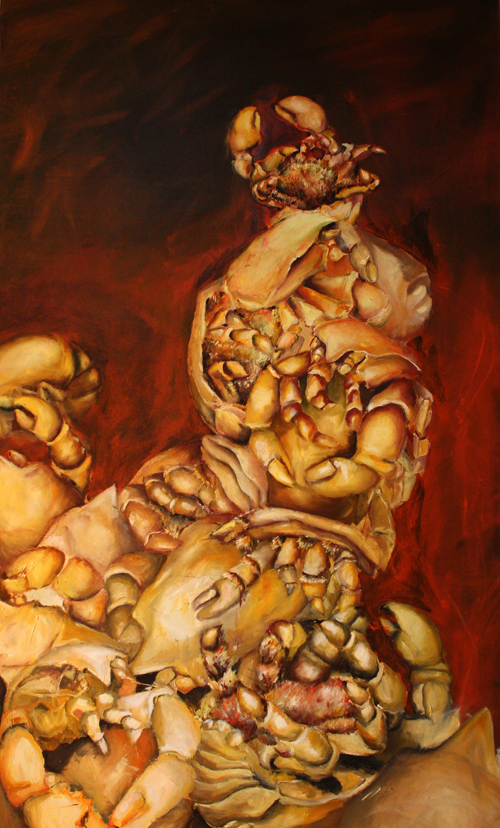
Lily Simonson. "Yeti Crab Volcano," 2012. Oil on canvas. 60x36 inches. Courtesy CB1 Gallery.
My chiaroscuro scenes of sea slug orgies and yeti crab dance parties typically embody the dialectic vacillation between attraction and repulsion. I tend to fall for invertebrates that uncannily resemble disembodied human bits, and my typical challenge is to find a way to render these abject animals in a way that highlights their more seductive qualities to play tug of war with their vaguely grotesque and alienlike morphologies. Moreover, their unfamiliar anatomy allows me to toy with abstraction and, like every other contemporary painter, allow the medium to become the subject. Joan Quinn as a subject turns these issues upside down. Adorned in baroque jewelry, her trademark hairstyle of punk red-streaked hair sets off her angular face–she is both categorically attractive and instantly recognizable not just as a human being but as Joan Quinn. Although Quinn puts me at ease by pointing out that she has no interest in being portrayed in a flattering or unflattering manner, I am mostly concerned with abjection and beauty, rather than ugliness and prettiness. Though I filled in most of the canvas in Quinn’s presence, my task as I complete the work will be to find a way to balance Quinn’s iconic appeal with some element of the abject.
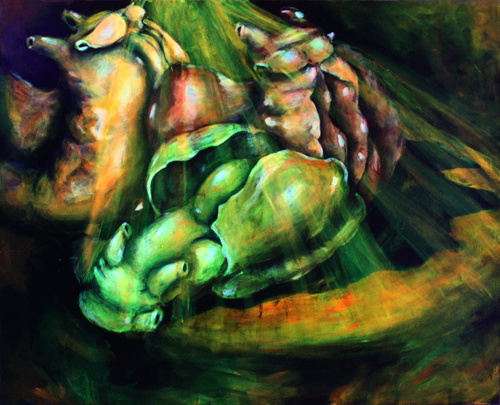
Lily Simonson. "Like Bunnies (Sea Hare Mating Chain)," 2012. Oil, acrylic and ultraviolet pigment on canvas. 48" x 60." Courtesy CB1 Gallery.
As Quinn sat modeling for me, I described my newest series of black light works, which embody a low brow/high brow duality by using fluorescent pigments–which glow under black light–with traditional Renaissance glazing techniques. Since fluorescent pigments are essentially transparent in normal light, I first paint the entire work with normal paints, so that the canvas will be a complete piece when viewed under traditional circumstances. After dusk, I turn off all the lights in my studio, fire up my army of black lights, and re-do the entire painting with UV reactive fluorescent pigment suspended in glazing medium. The glow of fluorescent pigment under black lights turns out to be a fantastic shortcut to evoking the luminosity achieved by my European chiaroscuro heros. When I expressed my impulse to paint Joan with this technique, she responded simply, “that would be something different.”
https://vimeo.com/43851658
Since most of my models and muses take the form of preserved specimens peeking through jars of ethanol, I am not accustomed to my subjects looking back at me. Joan Quinn does more than return the gaze–she serves it. Quinn is a consummate straight-shooter and profoundly perceptive—even correctly guessing my astrological sign (Virgo). Known for constantly snapping photos at art happenings (well before the digital age) she also documented me documenting her, clicking her camera in my direction as I painted. At the end of next month, it will be my turn to sit for Quinn when she interviews me in her TV studio for The Joan Quinn Profiles.
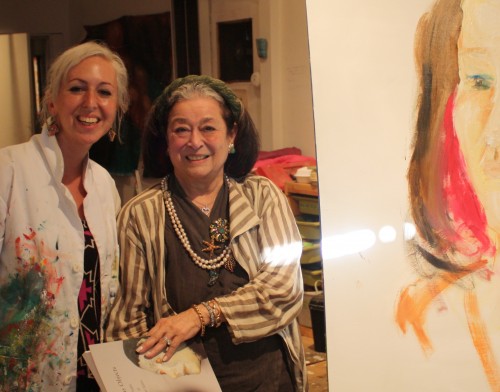
Lily Simonson and Joan Quinn, with portrait of Quinn in progress, June 26, 2012. Courtesy Lily Simonson.
As it happens, painting a living breathing model rather than a long-dead specimen this week provided me with some much needed practice for my next venture. Since my muses tend to be unusual deep sea invertebrates, I often visit far-flung marine labs to view rare specimens. But this Saturday, June 30, I will seek them out in their natural habitat as the artist-in-residence on the upcoming San Diego Coastal Expedition, where I will join researchers from the Scripps Institution of Oceanography. For nearly two weeks aboard the R/V Melville we will explore the ecosystems of the continental margin. I will have the rare opportunity to observe and paint still-living fauna as it is collected from the deep sea chemical seeps and oxygen minimum zones by the expedition’s robotic submersible vehicle. For some gonzo blogging from the sea floor, tune into my Boat Diaries, hosted by the CB1 Gallery blog.
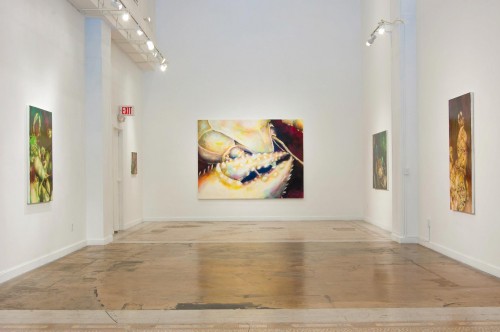
Lily Simonson, "Wet and Wild," East Gallery installation view, CB1 Gallery, Los Angeles, 2012. Courtesy Jay Oligny and CB1 Gallery.




Pingback: From Dead Bugs and Sea Critters to a Living Breathing Human. | Lily Simonson's Boat Diaries